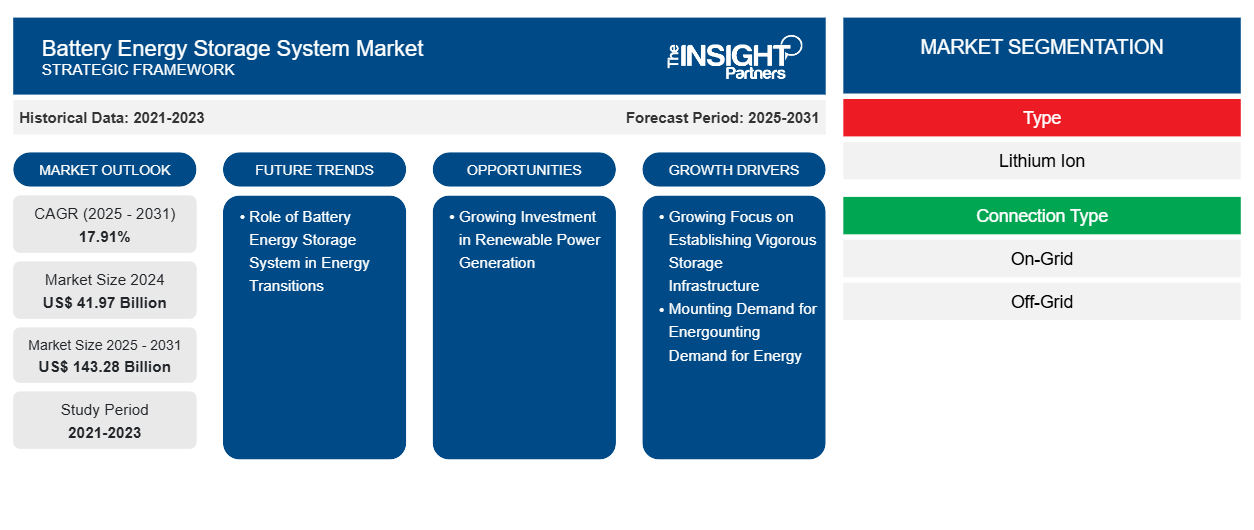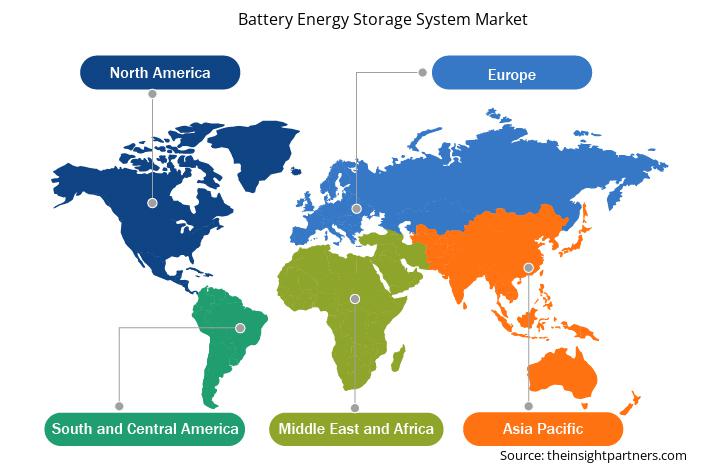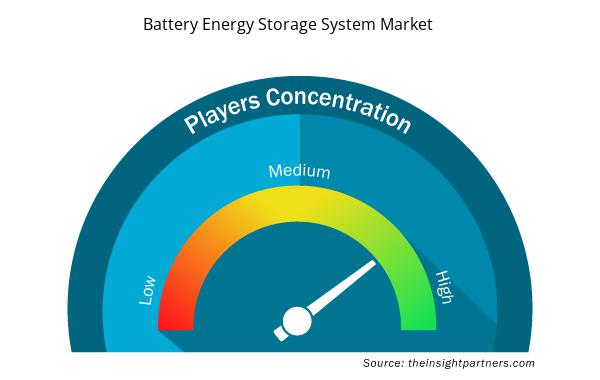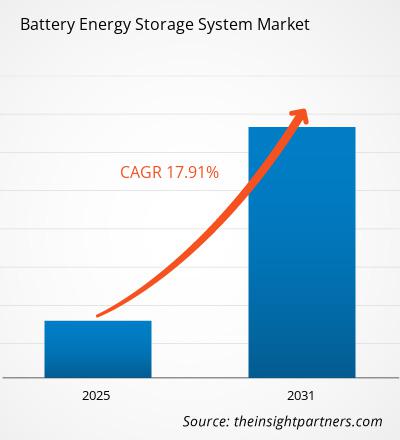バッテリーエネルギー貯蔵システムの市場規模は、2024年の419億7,000万米ドルから2031年には1,432億8,000万米ドルに達すると予測されています。市場は2025年から2031年の間に17.91%のCAGRを記録すると予想されています。エネルギー転換におけるバッテリーエネルギー貯蔵システムの役割は、今後数年間で市場に新たな主要トレンドをもたらす可能性があります。
バッテリーエネルギー貯蔵システム市場分析
再生可能エネルギー産業の急速な成長、バッテリーエネルギー貯蔵システムの需要の急増、および公益事業ベースの再生可能エネルギープロジェクトに対する政府の資金提供の増加は、バッテリーエネルギー貯蔵システム市場を活性化させる主な要因です。さらに、世界中で再生可能発電への投資が増加しているため、予測期間中に市場で活動する主要企業に有利な機会が生まれると予想されます。さらに、エネルギー移行におけるバッテリーエネルギー貯蔵システムの役割は、2025年から2031年までの市場における主要な将来のトレンドになると予想されます。
エネルギー生産者、送電システム運用者、ストレージ プロバイダー、およびエンド ユーザーは、バッテリー エネルギー ストレージ システムのエコシステムに関与する利害関係者です。エネルギーを生成するために使用されるソースには、天然ガス、化石燃料、および再生可能リソース (風力や太陽光など) が含まれます。発電の後には、送電とストレージのプロセスが続きます。エネルギー ストレージ プロセスには、大規模な施設と分散型電力またはエネルギー ストレージ システムが含まれます。最終ステップは、保存されたエネルギーをエンド ユーザーまたは主要なアプリケーション領域に分配することです。バッテリー エネルギー ストレージ システムのエンド ユーザーに、発電所、商業、住宅、および公共事業部門が含まれます。
バッテリーエネルギー貯蔵システム市場の概要
バッテリーエネルギー貯蔵システム(BESS)は、グリッドの回復力と信頼性を強化します。さらに、このシステムは裁定取引を通じて電気料金を下げ、バックアップ電源を提供することで削減のリスクを軽減します。これらの利点により、北米、ヨーロッパ、アジア太平洋などの地域、特に米国、ドイツ、英国、イタリア、中国、インド、日本、韓国の開発者や政府は、バッテリーエネルギー貯蔵インフラにさらに重点を置くようになりました。たとえば、州政府はエネルギー貯蔵と太陽光発電の統合をますます奨励しています。米国では、インフレ削減法(IRA)により、太陽光発電と貯蔵システムおよび独立型バッテリーエネルギー貯蔵システムの設置に対して税額控除が提供されており、これは米国のバッテリーエネルギー貯蔵システム市場に利益をもたらしています。
インド政府は、輸入セルへの依存を減らし、国内の産業発展を促進することを目的として、2021年5月に先進化学セルの生産連動インセンティブ制度を導入しました。この制度は、財政的インセンティブを通じてエネルギー貯蔵セグメントにおけるインドの製造能力を高めることを目指しています。インド政府は、2023年に4,000MWhのバッテリーエネルギー貯蔵システムを設置するための実行可能性ギャップ資金(VGF)制度を承認しました。この制度には、BESSの資本支出の最大約40%までのVGFの規定があり、 BESSから得られる電力の費用が削減されます。
要件に合わせてレポートをカスタマイズする
このレポートの一部、国レベルの分析、Excelデータパックなど、あらゆるレポートを無料でカスタマイズできます。また、スタートアップや大学向けのお得なオファーや割引もご利用いただけます。
バッテリーエネルギー貯蔵システム市場:

- このレポートの主要な市場動向を入手してください。この無料サンプルには、市場動向から見積もりや予測に至るまでのデータ分析が含まれます。
バッテリーエネルギー貯蔵システム市場の推進要因と機会
エネルギー需要の高まりがバッテリーエネルギー貯蔵システム市場を後押し
人口増加と都市化の進展は、特に米国、中国、インド、日本などの国々で、世界的にエネルギーの使用を左右するいくつかの要因です。米国エネルギー情報局(EIA)によると、米国のエネルギー消費は経済と人口の増加により2050年までに増加すると予想されています。EIAはまた、米国の電力最終消費量が2021年よりも2022年に約3.2%増加したと報告しました。さらに、2025年には電力消費が0.7%増加すると予測しています。バッテリーエネルギー貯蔵は、危機的状況や電力網が利用できない遠隔地や遠隔地での潜在的な用途があります。さらに、世界中でエネルギーの不確実性が高まっているため、米国政府はバッテリーエネルギー貯蔵システムの適用を奨励しています。例えば、2024年5月、Plus Powerはアリゾナ州を拠点とする90MW/360MWhのSuperstition BESSプロジェクトのためにモルガン・スタンレー銀行から8,200万米ドルのタックス・エクイティ投資を確保しました。このプロジェクトは2024年6月に稼働開始予定です。2024年2月、RWEはテキサス州とアリゾナ州で合計190MW(361MWh)の新しいバッテリーエネルギー貯蔵システム3基の建設を完了しました。
カナダにおけるエネルギー需要の高まりも、バッテリーエネルギー貯蔵市場の成長を後押ししています。たとえば、SolarBank Corporation は、2025 年 2 月後半にオンタリオ州で初のバッテリーエネルギー貯蔵システム プロジェクトの建設を開始する予定です。カナダ王立銀行は、この 4.99 MW BESS プロジェクトの建設に 2,580 万ドルの資金を提供する予定です。
成長機会を生み出す再生可能エネルギー発電への投資拡大
米国政府は、二酸化炭素排出量の削減に注力しており、国全体でクリーンエネルギーへの移行を推進しています。その結果、政府はグリーンエネルギー生産への投資を奨励しています。化石燃料を使用した発電は、気候変動につながる温室効果ガス(GHG)排出の主な原因です。クリーンエネルギーとグリーンエネルギーの使用への注目の高まり、気候変動への懸念の高まり、米国全土での再生可能エネルギーの使用を奨励する政府の取り組みにより、太陽光と風力エネルギーの利用が増加しています。2030年までに、米国政府は、2005年のレベルと比較して正味のGHG排出量を約50〜52%削減し、2050年までに正味ゼロ排出を達成することを目標としています。したがって、温室効果ガス排出に関する懸念の高まりから、再生可能発電への投資が促進されており、予測期間中にバッテリーエネルギー貯蔵システム市場の発展に有利な機会を提供することが期待されています。
アジア太平洋地域のさまざまな国の政府は、再生可能発電設備の増加を目標としています。2023年、インド政府は、2030年末までに300GWの目標を達成するために、今後5年間で毎年50GWの再生可能エネルギー容量の入札通知を発表しました。同様に、日本政府は、2022年の0.14GWから2030年末までに10GWに洋上風力発電容量を増やすことを目標としています。さらに、中国は2023年にこれらのシステムの設置を完了することで、2030年の再生可能エネルギー目標を6年先取りしています。したがって、予測期間中に再生可能発電への投資の増加により、バッテリーエネルギー貯蔵システム市場に成長の機会が生まれます。
バッテリーエネルギー貯蔵システム市場レポートのセグメンテーション分析
バッテリーエネルギー貯蔵システム市場分析の導出に貢献した主要なセグメントは、タイプ、接続タイプ、およびエンドユーザーです。
- タイプ別に見ると、市場はリチウムイオンとその他に分かれており、2024年にはリチウムイオンセグメントが市場で大きなシェアを占めることになります。
- 接続タイプに基づいて、バッテリーエネルギー貯蔵システム市場はオングリッドとオフグリッドに分かれています。オングリッドセグメントは2024年に市場を支配しました。
- エンドユーザー別に見ると、バッテリーエネルギー貯蔵システム市場は、商業用、公益事業用、住宅用に分類されます。2024年には公益事業部門が最大の市場シェアを占めました。
地域別バッテリーエネルギー貯蔵システム市場シェア分析
バッテリーエネルギー貯蔵システム市場レポートの地理的範囲は、詳細な世界、地域、および国別分析を提供します。北米、ヨーロッパ、アジア太平洋は、市場の成長に大きく貢献している主要地域です。北米は、2024年に47.8%のシェアでバッテリーエネルギー貯蔵システム市場を支配し、予測期間中も引き続き市場を支配しそうです。ヨーロッパは、バッテリーエネルギー貯蔵システム市場への2番目に大きな貢献者であり、アジア太平洋がそれに続きます。米国と中国は、政府のイニシアチブと再生可能エネルギー発電への投資の増加、マイクログリッドとバッテリーエネルギー貯蔵システムの容量の拡大により、バッテリーエネルギー貯蔵システム市場の大幅な成長を目の当たりにしている主要国です。再生可能エネルギーの採用に関する意識の高まりと、太陽光および風力エネルギープロジェクトへの投資の増加により、米国でのエネルギー貯蔵用のリチウムイオン電池の需要が高まっています。2023年、米国では、再生可能エネルギーの設置が2021年と比較して約37%増加し、2022年の設置と比較して51%増加しました。
一部の地域では停電時や送電網へのアクセスが制限されている際のバックアップ電源の需要が高まるため、米国ではBESSの必要性が高まると予想されます。さらに、安定した信頼性の高い電力供給を確保するために、米国全土のマイクログリッドやオフグリッドシステムでバッテリーエネルギー貯蔵システムの使用が増加しています。さらに、全国の太陽光発電および風力発電プロジェクトの開発に向けた投資と取り組みにより、今後数年間でバッテリーエネルギー貯蔵システム市場の成長が促進されると予想されます。2023年には、テキサス州が地域全体に約6,500MWの太陽光発電システムを設置し、カリフォルニア州を上回り、米国最大の再生可能エネルギー設置州となりました。
バッテリーエネルギー貯蔵システム市場レポートの対象範囲と成果物
「バッテリーエネルギー貯蔵システム市場の規模と予測(2021〜2031年)」レポートでは、以下の分野をカバーする市場の詳細な分析を提供しています。
- 対象範囲に含まれるすべての主要市場セグメントにおける国レベルのバッテリーエネルギー貯蔵システム市場規模と予測
- バッテリーエネルギー貯蔵システム市場の動向、および推進要因、制約、主要な機会などの市場動向
- 詳細なPESTおよびSWOT分析
- 主要な市場動向、国の枠組み、主要プレーヤー、規制、最近の市場動向を網羅したバッテリーエネルギー貯蔵システム市場分析
- 市場集中、ヒートマップ分析、主要プレーヤー、バッテリーエネルギー貯蔵システム市場の最近の動向を網羅した業界の状況と競争分析
- 詳細な企業プロフィール
レポートの範囲
バッテリーエネルギー貯蔵システム市場の地域別洞察
予測期間を通じてバッテリーエネルギー貯蔵システム市場に影響を与える地域的な傾向と要因は、Insight Partners のアナリストによって徹底的に説明されています。このセクションでは、北米、ヨーロッパ、アジア太平洋、中東およびアフリカ、南米および中米にわたるバッテリーエネルギー貯蔵システム市場のセグメントと地理についても説明します。

- バッテリーエネルギー貯蔵システム市場の地域別データを入手
バッテリーエネルギー貯蔵システム市場レポートの範囲
| レポート属性 | 詳細 |
|---|---|
| 2024年の市場規模 | 419.7億米ドル |
| 2031年までの市場規模 | 1,432.8億米ドル |
| 世界のCAGR(2025年~2031年) | 17.91% |
| 履歴データ | 2021-2023 |
| 予測期間 | 2025-2031 |
| 対象セグメント | タイプ別
|
| 対象地域と国 | 北米
|
| 市場リーダーと主要企業プロフィール |
|
バッテリーエネルギー貯蔵システム市場のプレーヤー密度:ビジネスダイナミクスへの影響を理解する
バッテリーエネルギー貯蔵システム市場は、消費者の嗜好の変化、技術の進歩、製品の利点に対する認識の高まりなどの要因により、エンドユーザーの需要が高まり、急速に成長しています。需要が高まるにつれて、企業は提供を拡大し、消費者のニーズを満たすために革新し、新たなトレンドを活用し、市場の成長をさらに促進しています。
市場プレーヤー密度とは、特定の市場または業界内で活動している企業または会社の分布を指します。これは、特定の市場スペースに、その規模または総市場価値と比較して、どれだけの競合相手 (市場プレーヤー) が存在するかを示します。
バッテリーエネルギー貯蔵システム市場で事業を展開している主要企業は次のとおりです。
- BYD株式会社
- サフトアメリカ株式会社
- キャトル
- テスラ株式会社
- サムスンSDI株式会社
- パナソニックホールディングス株式会社
免責事項:上記の企業は、特定の順序でランク付けされていません。

- バッテリーエネルギー貯蔵システム市場のトップキープレーヤーの概要を入手
- 過去2年間の分析、基準年、CAGRによる予測(7年間)
- PEST分析とSWOT分析
- 市場規模価値/数量 - 世界、地域、国
- 業界と競争環境
- Excel データセット



Report Coverage
Revenue forecast, Company Analysis, Industry landscape, Growth factors, and Trends

Segment Covered
This text is related
to segments covered.

Regional Scope
North America, Europe, Asia Pacific, Middle East & Africa, South & Central America

Country Scope
This text is related
to country scope.
よくある質問
The lithium-ion segment led the battery energy storage system market with a significant share in 2024.
The global battery energy storage system market is expected to reach US$ 143.28 billion by 2031.
Asia Pacific is anticipated to grow at the fastest CAGR over the forecast period.
Role of battery energy storage system in energy transitions is expected to drive the growth of the global battery energy storage system market in the coming years.
The key players operating in the global battery energy storage system market include BYD Co. Ltd; Samsung SDI Co Ltd; Panasonic Holdings Corp; Contemporary Amperex Technology Co Ltd; Tesla Inc; AES Corp; Ameresco Inc; Siemens AG; KORE Power Inc; General Electric Co; NextEra Energy Inc; Eos Energy Enterprises Inc; Saft Groupe SA; LG Chem Ltd; and ESS Inc.
Growing Focus on Establishing Vigorous Storage Infrastructure; and Mounting Demand for Energy are some of the major drivers of the global battery energy storage system market.
The global battery energy storage system market was valued at US$ 41.97 billion in 2024; it is expected to register a CAGR of 17.91% during 2025–2031.
Trends and growth analysis reports related to Energy and Power : READ MORE..
The List of Companies - Battery Energy Storage System Market
- BYD Co. Ltd
- Samsung SDI Co Ltd
- Panasonic Holdings Corp
- Contemporary Amperex Technology Co Ltd
- Tesla Inc
- AES Corp
- Ameresco Inc
- Siemens AG
- KORE Power Inc
- General Electric Co
- NextEra Energy Inc
- Eos Energy Enterprises Inc
- Saft Groupe SA
- LG Chem Ltd
- ESS Inc
The Insight Partners performs research in 4 major stages: Data Collection & Secondary Research, Primary Research, Data Analysis and Data Triangulation & Final Review.
- Data Collection and Secondary Research:
As a market research and consulting firm operating from a decade, we have published and advised several client across the globe. First step for any study will start with an assessment of currently available data and insights from existing reports. Further, historical and current market information is collected from Investor Presentations, Annual Reports, SEC Filings, etc., and other information related to company’s performance and market positioning are gathered from Paid Databases (Factiva, Hoovers, and Reuters) and various other publications available in public domain.
Several associations trade associates, technical forums, institutes, societies and organization are accessed to gain technical as well as market related insights through their publications such as research papers, blogs and press releases related to the studies are referred to get cues about the market. Further, white papers, journals, magazines, and other news articles published in last 3 years are scrutinized and analyzed to understand the current market trends.
- Primary Research:
The primarily interview analysis comprise of data obtained from industry participants interview and answers to survey questions gathered by in-house primary team.
For primary research, interviews are conducted with industry experts/CEOs/Marketing Managers/VPs/Subject Matter Experts from both demand and supply side to get a 360-degree view of the market. The primary team conducts several interviews based on the complexity of the markets to understand the various market trends and dynamics which makes research more credible and precise.
A typical research interview fulfils the following functions:
- Provides first-hand information on the market size, market trends, growth trends, competitive landscape, and outlook
- Validates and strengthens in-house secondary research findings
- Develops the analysis team’s expertise and market understanding
Primary research involves email interactions and telephone interviews for each market, category, segment, and sub-segment across geographies. The participants who typically take part in such a process include, but are not limited to:
- Industry participants: VPs, business development managers, market intelligence managers and national sales managers
- Outside experts: Valuation experts, research analysts and key opinion leaders specializing in the electronics and semiconductor industry.
Below is the breakup of our primary respondents by company, designation, and region:

Once we receive the confirmation from primary research sources or primary respondents, we finalize the base year market estimation and forecast the data as per the macroeconomic and microeconomic factors assessed during data collection.
- Data Analysis:
Once data is validated through both secondary as well as primary respondents, we finalize the market estimations by hypothesis formulation and factor analysis at regional and country level.
- Macro-Economic Factor Analysis:
We analyse macroeconomic indicators such the gross domestic product (GDP), increase in the demand for goods and services across industries, technological advancement, regional economic growth, governmental policies, the influence of COVID-19, PEST analysis, and other aspects. This analysis aids in setting benchmarks for various nations/regions and approximating market splits. Additionally, the general trend of the aforementioned components aid in determining the market's development possibilities.
- Country Level Data:
Various factors that are especially aligned to the country are taken into account to determine the market size for a certain area and country, including the presence of vendors, such as headquarters and offices, the country's GDP, demand patterns, and industry growth. To comprehend the market dynamics for the nation, a number of growth variables, inhibitors, application areas, and current market trends are researched. The aforementioned elements aid in determining the country's overall market's growth potential.
- Company Profile:
The “Table of Contents” is formulated by listing and analyzing more than 25 - 30 companies operating in the market ecosystem across geographies. However, we profile only 10 companies as a standard practice in our syndicate reports. These 10 companies comprise leading, emerging, and regional players. Nonetheless, our analysis is not restricted to the 10 listed companies, we also analyze other companies present in the market to develop a holistic view and understand the prevailing trends. The “Company Profiles” section in the report covers key facts, business description, products & services, financial information, SWOT analysis, and key developments. The financial information presented is extracted from the annual reports and official documents of the publicly listed companies. Upon collecting the information for the sections of respective companies, we verify them via various primary sources and then compile the data in respective company profiles. The company level information helps us in deriving the base number as well as in forecasting the market size.
- Developing Base Number:
Aggregation of sales statistics (2020-2022) and macro-economic factor, and other secondary and primary research insights are utilized to arrive at base number and related market shares for 2022. The data gaps are identified in this step and relevant market data is analyzed, collected from paid primary interviews or databases. On finalizing the base year market size, forecasts are developed on the basis of macro-economic, industry and market growth factors and company level analysis.
- Data Triangulation and Final Review:
The market findings and base year market size calculations are validated from supply as well as demand side. Demand side validations are based on macro-economic factor analysis and benchmarks for respective regions and countries. In case of supply side validations, revenues of major companies are estimated (in case not available) based on industry benchmark, approximate number of employees, product portfolio, and primary interviews revenues are gathered. Further revenue from target product/service segment is assessed to avoid overshooting of market statistics. In case of heavy deviations between supply and demand side values, all thes steps are repeated to achieve synchronization.
We follow an iterative model, wherein we share our research findings with Subject Matter Experts (SME’s) and Key Opinion Leaders (KOLs) until consensus view of the market is not formulated – this model negates any drastic deviation in the opinions of experts. Only validated and universally acceptable research findings are quoted in our reports.
We have important check points that we use to validate our research findings – which we call – data triangulation, where we validate the information, we generate from secondary sources with primary interviews and then we re-validate with our internal data bases and Subject matter experts. This comprehensive model enables us to deliver high quality, reliable data in shortest possible time.

 このレポートの無料サンプルを入手する
このレポートの無料サンプルを入手する